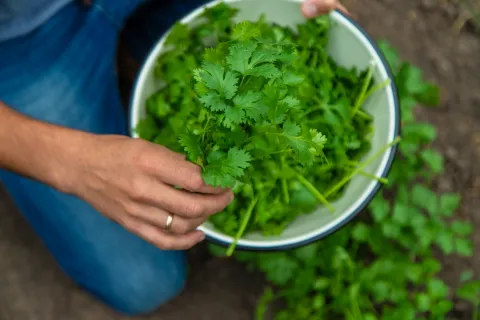
Scientific Name
Coriandrum sativum
General Information
Cilantro is a cool season annual herb also known as Chinese parsley. The flowers are very attractive to small beneficial insects, including syrphid flies and parasitic wasps. The leaf, flower, root, and seeds are edible. It is used as a garnish in many cuisines.
When to Plant
Sow seed in early spring or fall.
Planting
Plant in full sun. Slow to germinate (up to 25 days) but easily grown from seed with patience. Because of taproot, it is best to direct seed.
Soil Requirements
Cilantro prefers well composted, loamy soil.
Water Requirements
Keep evenly moist but do not overwater.
Fertilizing
Amend soil with compost.
Pollination
Cilantro is pollinated by insects.
Harvesting
Harvest outer leaves about one month after sowing seed. New growth emerges from center stem. Harvest seed as it turns from green to tannish color in the morning before dew dries to minimize seed shatter. Leaves do not dry well
Storage
Store dried seeds in glass jars to use until next season.
Good Varieties for Marin
Home gardeners usually grow cilantro for its leaf. Slow to bolt varieties include ‘Calypso’, ‘Santo’, and ‘Slo-Bolt’.
Helpful Tips
Pick fresh leaves any time after plant is 6 inches tall. Cut stems can be stored in water in the refrigerator.
Common Problems
This annual herb is quick to bolt. Leaves can develop bacterial leaf spot, a seedborne pathogen. Use reliable seeds and avoid overhead watering as bacteria can move from plant to plant. Also practice crop rotation.
Pests- Diseases & More
Relatively pest free.


